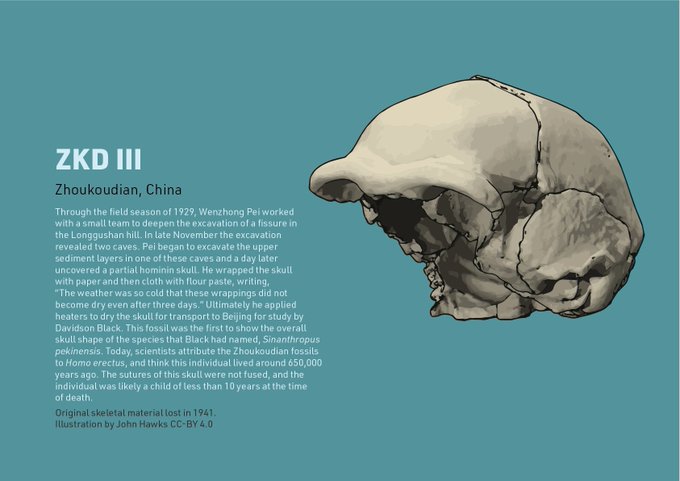paleoanthropologyのTwitterイラスト検索結果。 121 件中 4ページ目
Apidima 1 may be the earliest European #hominin fossil aligned with African ancestors of modern people, more than 210,000 years old. But some specialists suggest it was an ancestor of Neandertals. Of course, it may be both. #paleoanthropology
The Dmanisi site has some of the most informative postcranial remains of Homo erectus, telling us about the body size and locomotion of this #hominin species. D4167 comes from an individual of around 155 cm in stature. #paleoanthropology
The late André Keyser was faced with the problem of extricating the DNH 7 #hominin skull from an ant colony and tangle of plant roots. The pieces today comprise the most complete known skull of Paranthropus robustus #paleoanthropology
The travertine site at Bilzingsleben, Germany, has fossils from straight-tusked elephants, woolly rhinos, and macaques dating to an interglacial probably 400,000 years ago. The #hominin population left tools and remains of at least two individuals. #paleoanthropology
The MH2 #hominin mandible is still being built, fragment by fragment, as pieces are recovered from Malapa and prepared in the lab. The skull of this adult Australopithecus sediba individual may be found within the breccia as well. #paleoanthropology
KNM-ER 3733 helped establish that #hominin evolution was a branching tree and not a straight line. Alan Walker famously cracked the skull into three pieces with a chisel to remove the hard rock from inside, enabling reconstruction of the face. #paleoanthropology #FossilFriday
As the smallest mandible in the highly variable Sterkfontein Member 4 #hominin sample, Stw 404 has been a key fossil in understanding whether all these fossils represent Australopithecus africanus, or some of them may represent a second, larger species. #paleoanthropology
The Canadian anatomist Davidson Black died at his desk in 1934 with the skull of Sinanthropus from Locus E beside him. This #hominin skull was unearthed by Wenzhong Pei in 1929 deep within a fissure cave in Longgushan, or "Dragon Bone Hill" #paleoanthropology
Some skulls of Homo erectus have exceptionally thick cranial bones. This #hominin individual from Sangiran, Indonesia, has a thickened bar of bone on the back, known as the nuchal torus, defining the area above the trapezius muscle. #paleoanthropology
The AL 400-1 #hominin jaw was chewed by a carnivore before it was fossilized 3.3 million years ago. This individual is attributed to Australopithecus afarensis. #paleoanthropology
BOU-VP-16/1 is one of three #hominin skulls from near Herto, Ethiopia, that bear cutmarks or other signs of mortuary practices. The discoveries came near some of the latest Acheulean handaxe-dominated assemblages in Africa, around 155,000 years old. #paleoanthropology
Estimates of the age of fossil #hominin children have come a long way in 50 years. Still, we have much to learn about the variation in enamel growth rates in some species, including Australopithecus afarensis. The LH 2 child died at around 3.25 years of age. #paleoanthropology
When John Robinson ran out of government funding and left Swartkrans for a month, he returned to find miners blasting out dripstone to sell to a toothpaste manufacturer. Over the next two years, his team retrieved #hominin fossils from the miners. #paleoanthropology #FossilFriday
By the late 1950s, scientists had recovered #hominin fossils that showed that Australopithecus and Paranthropus were bipeds in a humanlike pattern. The pelvis evolved a form different from any other living or fossil primates. #paleoanthropology
The Stw 573 fossil #hominin skeleton is in the news today, for an interesting high-resolution examination of the bone tissue of its jaw. The skull first came to light in 1998. #paleoanthropology
The Steinheim skull has been a puzzle in #paleoanthropology. Today, we know that genetic exchanges with Africa influenced early Neandertals, and #hominin fossils from Apidima, Greece close in age to Steinheim may reflect this mixing. Why not this one too? #FossilFriday
We still don't know why the Ngandong fossil bed has so many—12— #hominin partial skulls, with no teeth or other bones except two tibiae. Early suggestions like cannibalism don't fully fit the data, but something curious happened to these H. erectus individuals. #paleoanthropology
The late Middle Pleistocene skull from Kabwe, Zambia, was uncovered a century ago. Today its place in the #hominin family tree is still an open question. Its population retained ancient diversity, yet may have been connected to modern people. #paleoanthropology #FossilFriday
The first skull to emerge from Dmanisi was D2280, also the largest at the site. Although this site no longer presents the earliest evidence of H. erectus, it remains the earliest #hominin fossil assemblage in Eurasia. #paleoanthropology
The tall rami of the SK 23 #hominin mandible match the tall faces of other fossils attributed to its species, Paranthropus robustus. Isotopic evidence suggests it ate the same range of foods as the smaller-toothed members of our own genus, Homo. #paleoanthropology




















